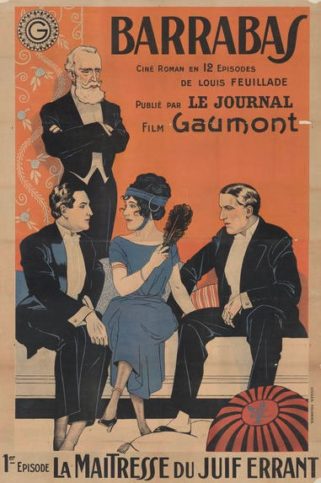 This thirteen part serial hails from 1919. It was the final crime-themed work of France’s incomparable Louis Feuillade, who made his name with dark, lurid sagas like FANTOMAS (1913) and LES VAMPIRES (1915). Other Feuillade serials include the thrillers JUDEX (1916) and TIH MINH (1918), and the melodramas PARISETTE (1921) and VINDICTA (1923). Popular opinion holds that BARRABAS is the weakest of Feuillade’s crime serials, and indeed it is.
This thirteen part serial hails from 1919. It was the final crime-themed work of France’s incomparable Louis Feuillade, who made his name with dark, lurid sagas like FANTOMAS (1913) and LES VAMPIRES (1915). Other Feuillade serials include the thrillers JUDEX (1916) and TIH MINH (1918), and the melodramas PARISETTE (1921) and VINDICTA (1923). Popular opinion holds that BARRABAS is the weakest of Feuillade’s crime serials, and indeed it is.
The problems besetting BARRABAS include the fact that there was apparently never a complete script, with the proceedings improvised as Feuillade went along (most noticeable in the climactic scenes, which finish things up in the most obvious way imaginable: a big explosion). Another issue is the lack of a galvanizing central figure on the level of Fantomas or LES VAMPIRES’S Irma Vep. Perhaps the most damaging thing of all is, ironically, the slickness of Feuillade’s direction.
By this point in his career (i.e. with all his truly noteworthy films behind him) Feuillade had grown quite technically proficient. In contrast to much of his earlier film work, which tended to be composed largely of wide shots, BARRABAS evinces a comparatively sophisticated use of varying lenses and camera set ups. What’s missing is the depth and inventiveness of his earlier films, with the visuals of BARRABAS being rather staid and unexciting.
BARRABAS evinces a comparatively sophisticated use of varying lenses and camera set ups.

Yet it’s a fact that even second tier Feuillade is eminently worthwhile. BARRABAS for all its faults is absorbing and exciting, and stands with its predecessors as the prototype of today’s action/thriller cinema.
BARRABAS begins with a brief prologue set in 1914. We’re introduced to the dashing journalist Raoul de Nerac, his lawyer friend Jacques Varese and the latter’s sister Francoise. Also in their circle is Rudolph Sterlitz, an elderly financier, and Lewis Mortimer, a wealthy American banker. The latter is saved from a seemingly random assault by Biscotin and the latter’s wife Biscotine, an eccentric pair of travelling salespeople who provide comic relief.
BARRABAS for all its faults is absorbing and exciting, and stands with its predecessors as the prototype of today’s action/thriller cinema.
The narrative then jumps forward five years. Raoul and Francois are now engaged and Lewis has apparently embarked on a never-ending business trip. In fact, Lewis has been taken hostage and killed by a criminal organization run by Strelitz, of whom it’s said “When one knows Strelitz, one must believe in Satan.” This organization goes by the password “Barrabas,” and brands its members with a distinctive tattoo.
Jacques Rougier, a criminal who was part of the attack on Lewis five years earlier, is getting released from prison. It seems he’s part of Barrabas and is consumed with guilt over the fact that he’s not actually who he says he is, with the identity he’s assumed being that of a committed family man and war hero. Rougier doesn’t have much time settle into his new life before he’s set up by his Barrabas-affiliated “friends” for the murder of Lewis Mortimer’s mistress. Loath to reveal his true identity, the faux-Rougier is guillotined for the killing, but leaves clues about his criminal affiliations in a specially marked copy of THE THREE MUSKETEERS he bequeaths to his attorney—who happens to be Jacques Varese.
All this, spread out over an eight hour canvas, comes complete with impressive stunt work (a narrow rescue in front of an oncoming train in particular) and spectacular aerial footage (with Raoul being an ace pilot who performs at least one plane rescue).
The latter is led by the clues in the book to one of Barrabas’s strongholds. This sets in motion a succession of intrigue as Strelitz attempts to get Varese to join his organization, Francois is held hostage in a dungeon below Barrabas’s secluded country manor, and Raoul and Biscotin team up to take down Strelitz
All this, spread out over an eight hour canvas, comes complete with impressive stunt work (a narrow rescue in front of an oncoming train in particular) and spectacular aerial footage (with Raoul being an ace pilot who performs at least one plane rescue). The performances, especially those of Gaston Michel as the goateed Strelitz and Fernand Herrmann as Jacques Varese, are generally strong (if unexceptional) and the pacing quite lively (for the silent era). BARRABAS is, in short, a first rate piece of pure entertainment by a filmmaker who really knew how to do it.
Vital Statistics
BARRABAS
Gaumont
Director: Louis Feuillade
Screenplay: Louis Feuillade, Maurice Level
Cinematography: Maurice Champreux, Georges Lafont, Leon Morizet
Editing: Maurice Champreux
Cast: Fernand Herrmann, Edouard Mathe, Gaston Michel, Georges Biscot, Blanche Montel, Jeanne Rollette, Albert Mayer, Lugane, Lyne Stanka, Violette Jyl, Laurent Morleas, Olinda Mano, Edmund Breon
